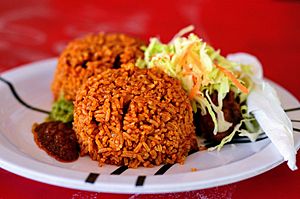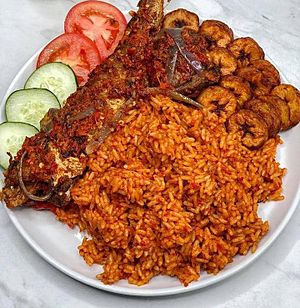Jollof rice facts for kids

Jollof rice with stew and garnish
|
|
| Alternative names | Benachin, riz au gras, ceebu jën, zaamè |
|---|---|
| Type | Rice dish |
| Region or state | West Africa |
| Main ingredients | Rice, tomatoes and tomato paste, onions, cooking oil, fish, lamb, goat meat, chicken, or beef |
Jollof (/dʒəˈlɒf/), also known as jollof rice, is a popular rice dish from West Africa. It's usually made with long-grain rice, tomatoes, onions, spices, vegetables, and meat. All these ingredients are cooked together in one pot. The exact ingredients and how it's made can be a bit different depending on where you are in West Africa.
Contents
Where Did Jollof Rice Come From?
Jollof rice started in the Senegambian region around the 14th century. This area was once ruled by the Wolof or Jolof Empire. Today, this region includes parts of Senegal, The Gambia, and Mauritania. Rice was grown there, and a traditional dish called thieboudienne, which has rice, fish, shellfish, and vegetables, is thought to be an ancestor of jollof.
Many people believe that jollof rice spread across West Africa with traders. These traders, especially the Djula, traveled widely. They shared their cooking methods and love for rice as they moved between different towns and cities.
Jollof Across West Africa
Jollof rice is one of the most common dishes you'll find in West Africa. It has different names and ingredients depending on the country. For example, in Mali, it's called zaamè. In Senegal and Gambia, people often call it ceebu jën or benachin. In French-speaking areas, it's known as riz au gras. Even with these differences, people across the region can recognize jollof. It has become the most famous African dish outside of Africa!
What's in Jollof Rice?
Traditional jollof rice uses rice and cooking oil. It also includes vegetables like tomatoes, onions, red peppers, garlic, ginger, and spicy Scotch bonnet chilli peppers. To make the dish a nice red color, tomato paste is often added.
For flavor, cooks use spices, salt, stock cubes (which are like flavor boosters), curry powder, and dried thyme. To make the meal complete, jollof rice is often served with chicken, turkey, beef, or fish.
Jollof Rivalry: Who Makes the Best?
Almost every West African country has its own way of making jollof rice. Countries like Ghana, Nigeria, Sierra Leone, Liberia, and Cameroon often compete to see who makes the best jollof. This friendly competition is especially strong between Nigeria and Ghana. People even call it the "Jollof Wars"!
Nigerian Jollof
Nigerian jollof rice usually starts with parboiled rice (rice that's partly cooked). It also includes tomatoes, tomato paste, peppers, vegetable oil, onions, and stock cubes. Most of the ingredients are cooked in one pot. A rich meat stock and a fried tomato and pepper sauce form the base. Then, the rice is added and cooks in this flavorful liquid. Nigerian jollof is often served with your choice of meat or chicken. It's also common to have it with fried plantains, moi moi (a steamed bean pudding), or a fresh salad. In areas near rivers, people often use seafood instead of meat.
Ghanaian Jollof
Ghanaian jollof rice is made with vegetable oil, onions, ginger, garlic, and chillies. It also uses tomato paste, beef, goat meat, or chicken. Sometimes mixed vegetables are added. The rice used is often jasmine rice. Black pepper is also a key ingredient.
First, the meat or chicken is seasoned and steamed with a mix of ginger, onions, and garlic. Then it's fried until it's well-cooked. Next, the other ingredients like onions, peppers, tomato paste, and spices are fried. After that, the rice is added and cooked until the dish is ready. Ghanaian jollof is usually served with fried fish, beef, or chicken. It's also often eaten with shito, a popular Ghanaian pepper sauce, and salad at parties.
Bissau-Guinean Jollof
Jollof rice from Guinea-Bissau is made with tomatoes, onions, tomato paste, red bell peppers, yellow bell peppers, garlic, and bay leaves. These ingredients are slowly cooked with vegetable oil and spices to create the classic jollof flavor. Ginger is often added to give it a spicy kick. This dish is usually served on its own, but sometimes it comes with chicken, okra, or fried plantains.
Jollof Around the World
Since the 2010s, more and more people in Western countries have become interested in West African foods. Jollof food festivals have been held in places like Washington, DC, USA, and Toronto, Canada. "World Jollof Day" is celebrated every year on August 22nd. It has become very popular on social media!
See also
 In Spanish: Arroz jollof para niños
In Spanish: Arroz jollof para niños


